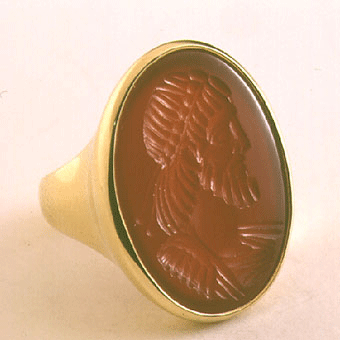Carnelian Intaglio Depicting Roman Emperor's Bust, 1700 CE - 1800 CE
Carnelian/Gold
FJ.5970
The art of glyptics, or carving on colored precious stones, is probably one of the oldest known to humanity. Intaglios, gems with an incised design, were made as early as...
The art of glyptics, or carving on colored precious stones, is probably one of the oldest known to humanity. Intaglios, gems with an incised design, were made as early as the fourth and third millennia B.C. in Mesopotamia and the Aegean Islands. They display a virtuosity of execution that suggests an old and stable tradition rooted in the earliest centuries. The tools required for carving gems were simple: a wheel with a belt-drive and a set of drills. Abrasives were necessary since the materials used were too hard for a metal edge. A special difficulty of engraving intaglios, aside from their miniature size, was that the master had to work with a mirror image in mind. What distinguishes the intaglios made in the 18th Century from those produced in the Renaissance is a more exact study of antique designs. The engravers attempted to equal or excel the masters of the past. The results were glyptics that could reach high standards of artistry. This beautiful intaglio, engraved on rich red carnelian, depicts a profile bust of what is most likely a Roman emperor. He bears a certain resemblance to the emperor Antoninus Pius; a handsome man with a thoughtful, philosophical turn of mind. To wear this ring brings together the elegant 18th. Century and ancient Rome, designed for someone who would be at home in both worlds.



